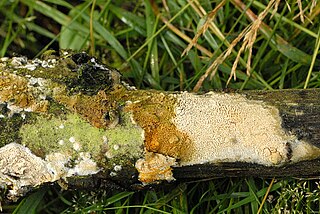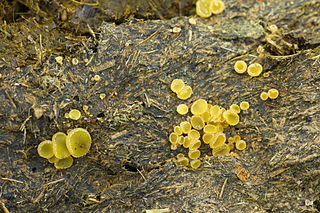
The Stereaceae are a family of corticioid fungi in the Russulales order. Species in the family have a widespread distribution, are lignicolous or terrestrial, and typically saprobic. According to the Dictionary of the Fungi, the family contains 22 genera and 125 species.

Rhizopogonaceae are a family of fungi in the order Boletales. The family, first named and described by botanists Ernst Albert Gäumann and Carroll William Dodge in 1928, contains 2 genera and 151 species. The genus Fevansia, formerly thought to belong in the Rhizopogonaceae, was found to belong in the Albatrellaceae in a molecular phylogenetics study.

The Bankeraceae are a family of fungi in the order Thelephorales. Taxa are terrestrial, and ectomycorrhizal with plant species in families such as Pinaceae or Fagaceae. The family was circumscribed by Marinus Anton Donk in 1961. According to a 2008 estimate, the family contains 6 genera and 98 species.

Schizoporaceae are a family of fungi in the order Hymenochaetales. These are saprobic, and cause white rots of standing and fallen wood of coniferous and broadleaved trees. According to one 2008 estimate, the family contains 14 genera and 109 species.

The Hymenochaetaceae are a family of fungi in the order Hymenochaetales. The family contains several species that are implicated in many diseases of broad-leaved and coniferous trees, causing heart rot, canker and root diseases, and also esca disease of grapevines. According to a standard reference text, the family contains 27 genera and 487 species.

The Phacidiaceae are a family of fungi in the order Helotiales. According to a 2008 estimate, the family contained seven genera and 148 species.

The Leotiaceae are a family of fungi in the order Leotiales. Species in this family are saprobic, and have a wide distribution, especially in temperate regions. The family contains 7 genera and 34 species.

The Bulgariaceae are a family of fungi in the order Helotiales. Species are found in northern and southern temperate regions. The family contains four genera and seven species.

The Lachnocladiaceae are a family of fungi in the order Russulales. A 2008 estimate places 124 species in 8 genera in the Lachnocladiaceae. Species of this family, which have a widespread distribution in both tropical and temperate zones, are typically found on decaying coniferous or deciduous wood. The family was circumscribed by British mycologist Derek Reid in 1965.

The Peniophoraceae are a family of fungi in the order Russulales. Species of this family have a cosmopolitan distribution and are mostly saprobic, causing rots of standing and fallen wood. According to a 2008 estimate, the family contains 7 genera and 88 species.

The Sarcoscyphaceae are a family of cup fungi in the order Pezizales. Members of the Sarcoscyphaceae are cosmopolitan in distribution, found in both tropical and temperate regions.

The Mycenaceae are a family of fungi in the order Agaricales. According to the Dictionary of the Fungi, the family contains 10 genera and 705 species. This is one of several families that were separated from the Tricholomataceae as a result of phylogenetic analyses. Taxa in the Mycenaceae are saprobic, have a cosmopolitan distribution, and are found in almost all ecological zones. The family was circumscribed by Caspar van Overeem in 1926.

The Sarcosomataceae are a family of fungi in the order Pezizales. According to a 2008 estimate, the family contains 10 genera and 57 species. Most species are found in temperate areas, and are typically saprobic on rotten or buried wood.
The Acaulosporaceae are a family of fungi in the order Diversisporales. Species in this family are widespread in distribution, and form arbuscular mycorrhiza and vesicles in roots. The family contains two genera and 31 species.

The Exobasidiaceae are a family of fungi in the division Basidiomycota, order Exobasidiales. The family contains 5 genera and 56 species. Species in the family have a widespread distribution, especially in temperate areas. Members of the Exobasidiaceae are plant pathogens that grow on the leaves of plants, especially those in the family Ericaceae.

Pucciniomycetes is a diverse class of fungi in the subphylum Pucciniomycotina of phylum Basidiomycota. The class contains 5 orders, 21 families, 190 genera, and approximately 8,016 species. It has been estimated that this class contains about one third of all teleomorphic basidiomycetes. Pucciniomycetes contains many economically important plant pathogenic fungal rusts; the order Pucciniales is the largest clade in this class, representing approximately 7,000 species.

Saccobolus is a genus of fungi in the Ascobolaceae family. The genus has a widespread distribution, and contains 27 species.

Ascobolus is a genus of fungi in the Ascobolaceae family. The genus has a widespread distribution, and contains an estimated 61 species, most of which are coprophilous. The genus was circumscribed by Christian Hendrik Persoon in 1796.

The Chaconiaceae are a family of rust fungi in the order Pucciniales. The family contains 8 genera and 75 species. Most species have a tropical distribution. Maravalia cryptostegiae has been used with success as a biocontrol agent against rubber vine in Australia.

The Leptosphaeriaceae are a family of fungi in the order Pleosporales. The family was circumscribed by mycologist Margaret E. Barr in 1987. According to the Dictionary of the Fungi, the family contains 8 genera and 302 species. The family has a widespread distribution, but is especially prevalent in temperate regions. Species are either saprobic or grow as nectrotrophs on the stems or leaves of plants.

























